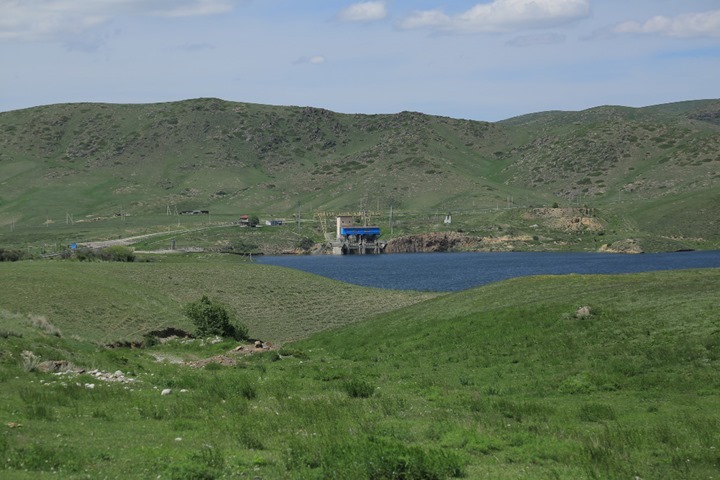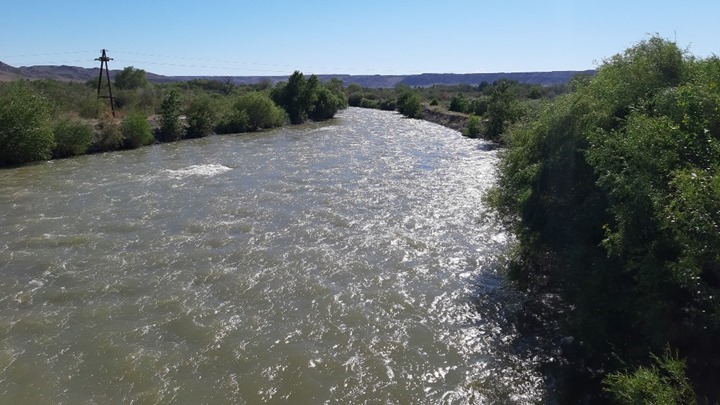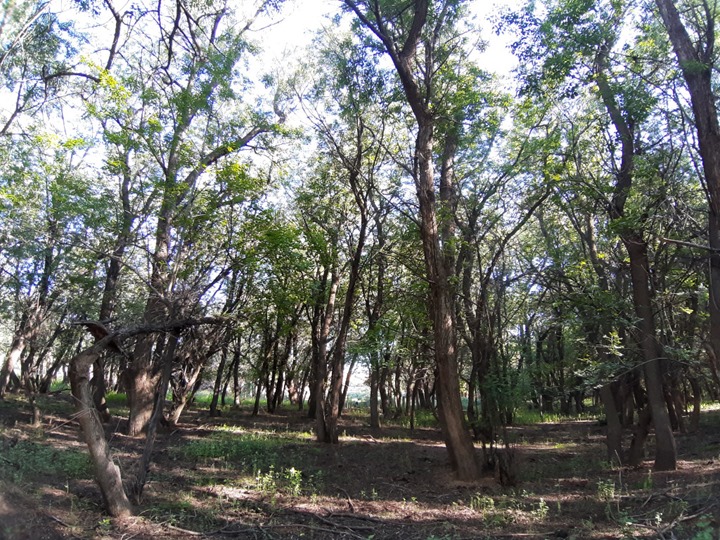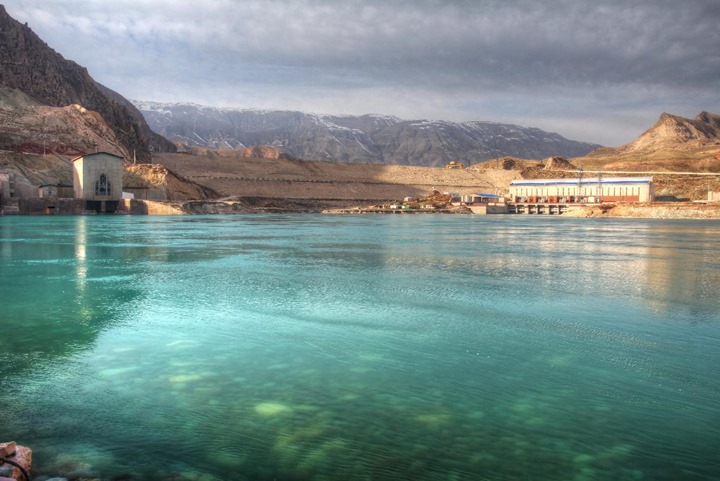How does the Moynak hydroelectric power station affect the Charyn Ash grove
In 2012, the Moynak hydroelectric power station with an installed capacity of 300 MW was commissioned on the Charyn River in the Raiymbek district of the Almaty region of the Republic of Kazakhstan. A 94-meter-high dam and the Bestyubinskoye reservoir were built for the operation of the hydroelectric power station.

The construction of the hydroelectric power station began in Soviet times, in 1985, but in 1992, due to the difficult economic situation, it was stopped. In early 2005, the Government decided to resume the construction of the Moynak hydroelectric power station.
The reservoir and the hydroelectric power station are located near the confluence of the Karkara and Kegen rivers, where the Charyn River begins.
The Moynak hydroelectric power station is an important energy infrastructure facility for the region, but its activities carry significant environmental risks.
Below the hydroelectric power station is the Charyn State National Natural Park. It was established in 2004 to preserve and restore the unique natural complexes of the Almaty region, which have a special ecological, historical, scientific, aesthetic and recreational value.
The national park includes the Charyn Ash Grove (or forest cottage), which is a state natural monument of national significance, it received this status back in 1964.
Recall that in accordance with the Law of the Republic of Kazakhstan “On Specially Protected Natural Areas”:
“The State monument of Nature is a specially protected natural area, including some unique, irreplaceable, valuable in ecological, scientific, cultural and aesthetic terms natural complexes, as well as objects of natural and artificial origin, classified as objects of the state nature reserve Fund” (Article 64).
Relict Sogdianus ash, or Sogdianus ash (Latin Fraxinus sogdiana), which is included in the Red Book of Kazakhstan. Some trees are over 300 years old. And the grove itself is a unique natural formation that originated in the pre–Glacial era. This is one of the few remaining islands of ancient forests in the world that once covered vast territories.
In addition to its ecological value, the grove impresses with its natural beauty. It attracts tourists, photographers and nature lovers. Locals consider this place sacred, and ancient legends associate the grove with the spirits of the earth.
Back in 1970-1980, within the framework of the feasibility study project of the Moynak hydroelectric power station and the Bestyubinsky reservoir on the Charyn River, research work was carried out and conclusions were drawn:
“The regulation of the river flow in connection with the construction of the reservoir and the impact of hydraulic structures will disrupt the natural hydrological regime of the river, negatively affect the preservation and natural renewal of the Ash Grove, which will lead to the complete loss of this unique natural object. It will also have a negative impact on the ecological systems of the Charyn Canyon.”
In 2005, when considering the project “Preliminary environmental impact assessment for the feasibility study of the construction of the Moynak HPP on the Charyn River of the Raiymbek district of Almaty region”, experts of the Forestry and Hunting Committee of the Ministry of Agriculture of the Republic of Kazakhstan identified a number of problems.

In the introduction, it was noted that floods and groundwater levels play a huge role in the process of growth and renewal of ash forests. Regular flooding of the floodplain is necessary to ensure natural renewal. It was expected that after the completion of the construction and commissioning of the HPP, the situation would become more complicated, since the flow would be regulated, and flood waters would linger in the reservoir that was operated in winter. The change in the natural flow of Charyn as a result of the construction and commissioning of the Moynak HPP with the existing water deficit will ultimately lead to a change in the environment of the Sarytogai tract and the change of moisture-loving rocks to more drought-resistant ones. The impact of the regulation of the reservoir level on the natural monument will consist in cutting off the peaks of floods, briefly flooding the floodplain and feeding groundwater. A decrease in the groundwater level and the absence of natural floods that contribute to the renewal will lead to the degradation of a unique natural monument. (Letter from KLOH No. 25-11-23/3011 dated 10/27/2005)
The power engineers promised that they would carry out ecological releases that would allow to leave a sufficient amount of water in the river, this would contribute to the preservation of the ecosystem in the lower reaches.
In 2019, the Ecological Society “Green Salvation” appealed to the Committee of Forestry and Wildlife (Ext. No. 017) with a request to report on the condition of the Ash Grove and whether it is affected by the change in the hydro regime of the Charyn River after the commissioning of the Moynak HPP.
Even then, experts noted that
“The state of the Ash Grove is monitored by the scientific Department of the National Park on an ongoing basis as part of the Chronicle of Nature observations. … Since the commissioning of the Moynak hydroelectric power station, the ash tree growing on the first terrace is in satisfactory condition, drying is observed on the second terrace. According to hydrometeorological data of weather stations of RSE “Kazhydromet”, from 2014 to 2017, the water level discharged from the Moynak HPP is not stable. In this regard, the national park on the second terrace produces watering five times in the summer. … The condition of the Ash Grove as a whole is satisfactory” (letter KLOH 17-1-27/ZT–K-57 dated 02/22/2019).
It’s been 5 years.
Ecological Society “Green Salvation” appealed to JSC “Moynakskaya HPP named after U.D. Kantaev” and to the Ministry of Water Resources and Irrigation of the Republic of Kazakhstan regarding the fulfillment of obligations of the HPP on environmental releases, as well as to the Forestry and Wildlife Committee to find out what condition the grove is in at the moment.
The management of the HPP reported that “in accordance with the protocol of the workshop dated September 24, 2019, the HPP releases water into the lower reaches of the Charyn River in May in the amount of 60 m3/sec for 10-15 days” (letter No. 16-14/173 dated 05/23/2024).
The Ministry of Water Resources and Irrigation of the Republic of Kazakhstan in its letter (No. ZT-2024-03966784 dated 05/23/2024) reported that “a hydroelectric complex with a reservoir–counterregulator was built on the river to transform the runoff into a natural regime.” In addition to environmental releases in May, the average discharge for May is 39.85 m3/s, for June – 40 m3/s, for July – 50 m3/s, for August – 50 m3/s, for September – 43 m3/s.
The Committee of Forestry and Wildlife in its letter No.ZT-2024-03966779 dated 06/20/2024 reported:
- Monitoring of the condition of Sogdiansky ash is carried out on an ongoing basis by specialists of the Department of Science of the Charyn State National Natural Park (hereinafter referred to as the National Park).
- Since the construction of the hydroelectric power station in the upper part of the Charyn River, fluctuations in the water level in the river have been observed. During the 13 years of construction of the Moynak hydroelectric power station, the ecological state of the Charyn ash grove has led to changes. Fluctuations in the water level in the Charyn contributed to the natural renewal of the Sogdiansky ash.
- It can be estimated that the natural renewal of the ash tree in the grove has moved from a good level to a satisfactory one (that is, it has deteriorated. — Approx.author). This is especially due to the increase in drought in the country over the past 5 years.
- The forestry and ecological condition and natural renewal of the Sogdiansky ash, which grows naturally on terrace No. 1 in the Ash Grove, can be assessed as satisfactory.
- In the grove since 1939 of the last century, plantations of Sogdiansky ash have been planted on terrace No. 2, but since then the survival rate of the plantations has not reached 30%. On terrace No. 2 in the Ash Grove, the ecological condition and natural renewal of plantations planted manually and naturally, the growth of ash trees can be assessed as average. The reason is that they wilt quickly if they are not watered regularly. One of the biological factors affecting the natural renewal of Sogdiansky ash is the yield of seeds. Fluctuations in seed yield in different years directly affect the natural renewal…
Consequently, experts confirm that the condition of the Ash Grove, though slowly, is deteriorating. A significant role in this process is played by the regulation of the natural flow of the Charyn River due to the construction of a dam and a hydroelectric power station.

Thus, the main risks for the grove are:
- Changes in the hydrological regime of the Charyn River. The operation of a hydroelectric power station requires the management of water flows, which leads to disruption of the natural hydrological cycle of the river. Irregular water runoff, artificial floods or a decrease in water volume threaten the ecosystem of the grove, which depends on sustainable water supply.
- Reduction of groundwater level. Charyn ash grove feeds not only on surface, but also groundwater. If the groundwater level decreases as a result of the influence of the existing hydroelectric power station, it can cause drought and mass death of trees.
- Threat to biodiversity. The grove is home to many rare and endemic species. Changes in the ecosystem can affect the number of insects, birds and animals that depend on relict ash trees.
- Soil erosion. Changes in the course and speed of the river can contribute to erosion of the banks. This will endanger the root system of trees and the overall stability of the forest.
- Potential accidents at the HPP. In case of technical malfunctions or emergency water discharges, the ecosystem of the grove may suffer from flash floods or pollution.
In May 2024, employees of the Ecological Society “Green Salvation” visited the Ash Grove as part of public monitoring of protected areas. With surprise, we noticed a large amount of manure. In accordance with the law on protected areas, “in the territories of state natural monuments, a protected protection regime corresponding to the type of protection regime of state natural reserves is established, with the prohibition of any activity entailing a violation of the preservation of state natural monuments.” Grazing is prohibited in the territories where a protected regime is established (articles 40 and 66).
Human activity poses a threat to this unique natural object. What awaits the relict grove in the future, which, according to scientists, was able to survive the Ice Age? Will specialists be able to protect a unique relic ecosystem? These questions remain open. And the task of preserving the natural heritage of Kazakhstan – the Charyn ash grove – remains relevant for the country!
Ecological Society “Green Salvation”


